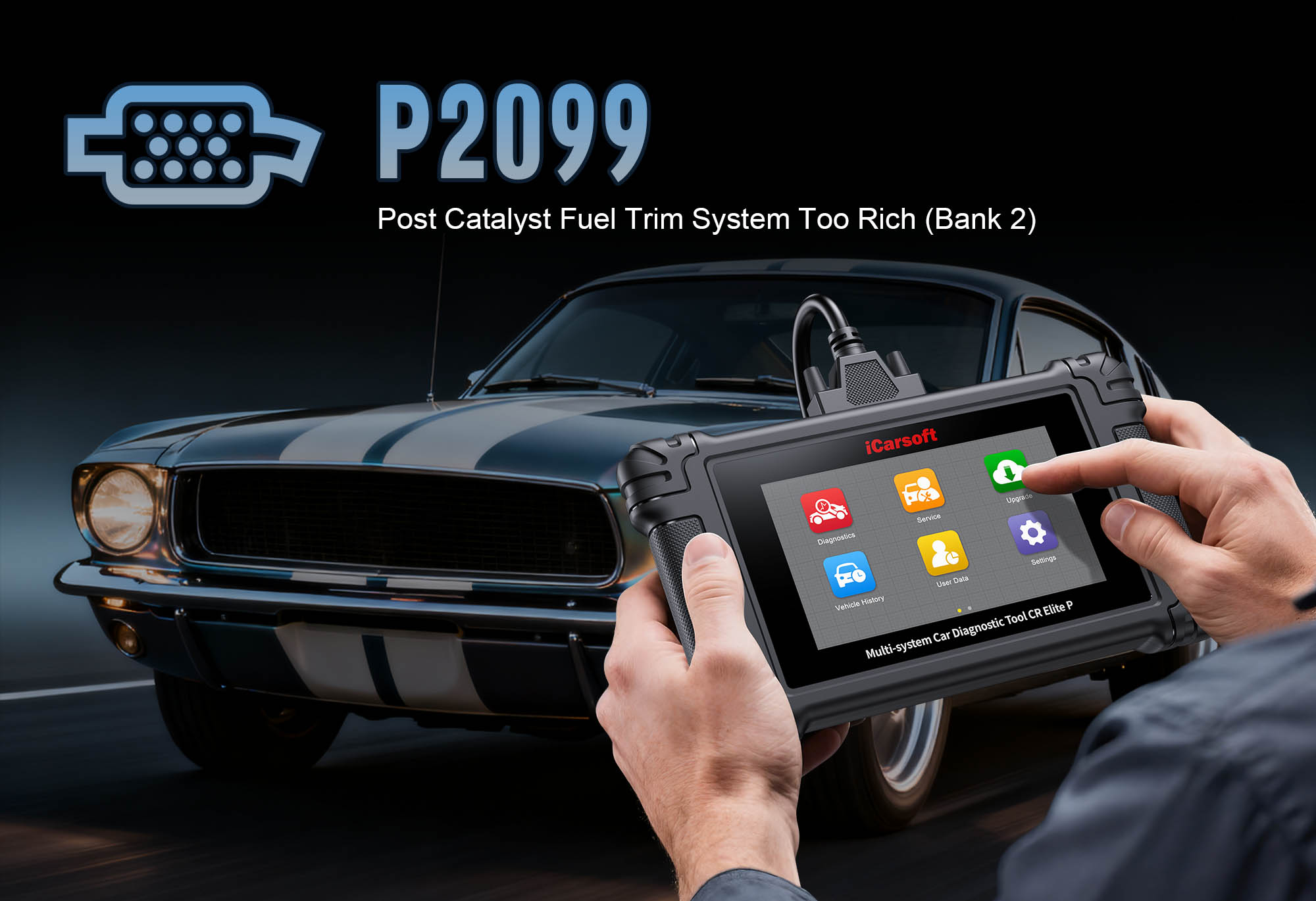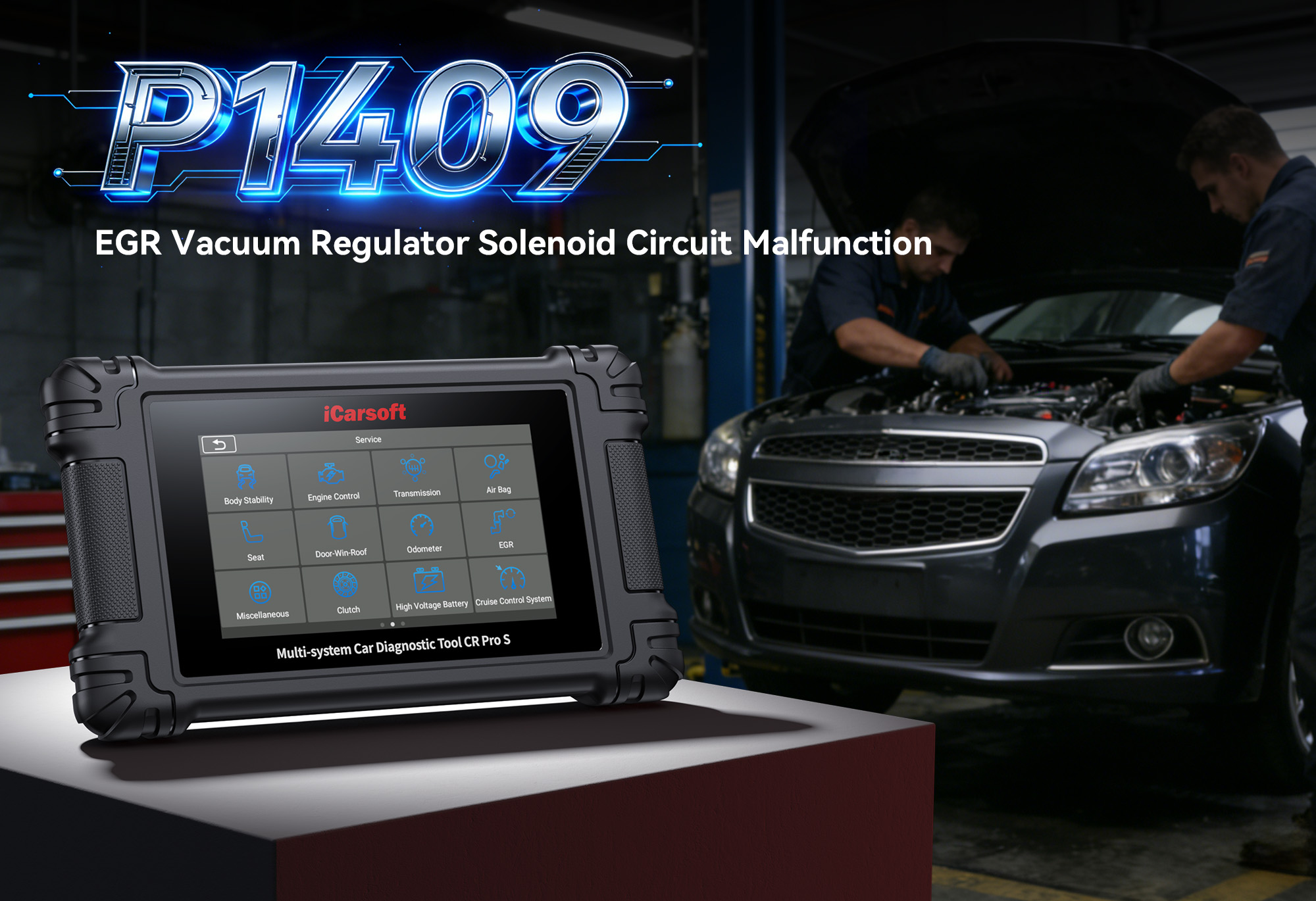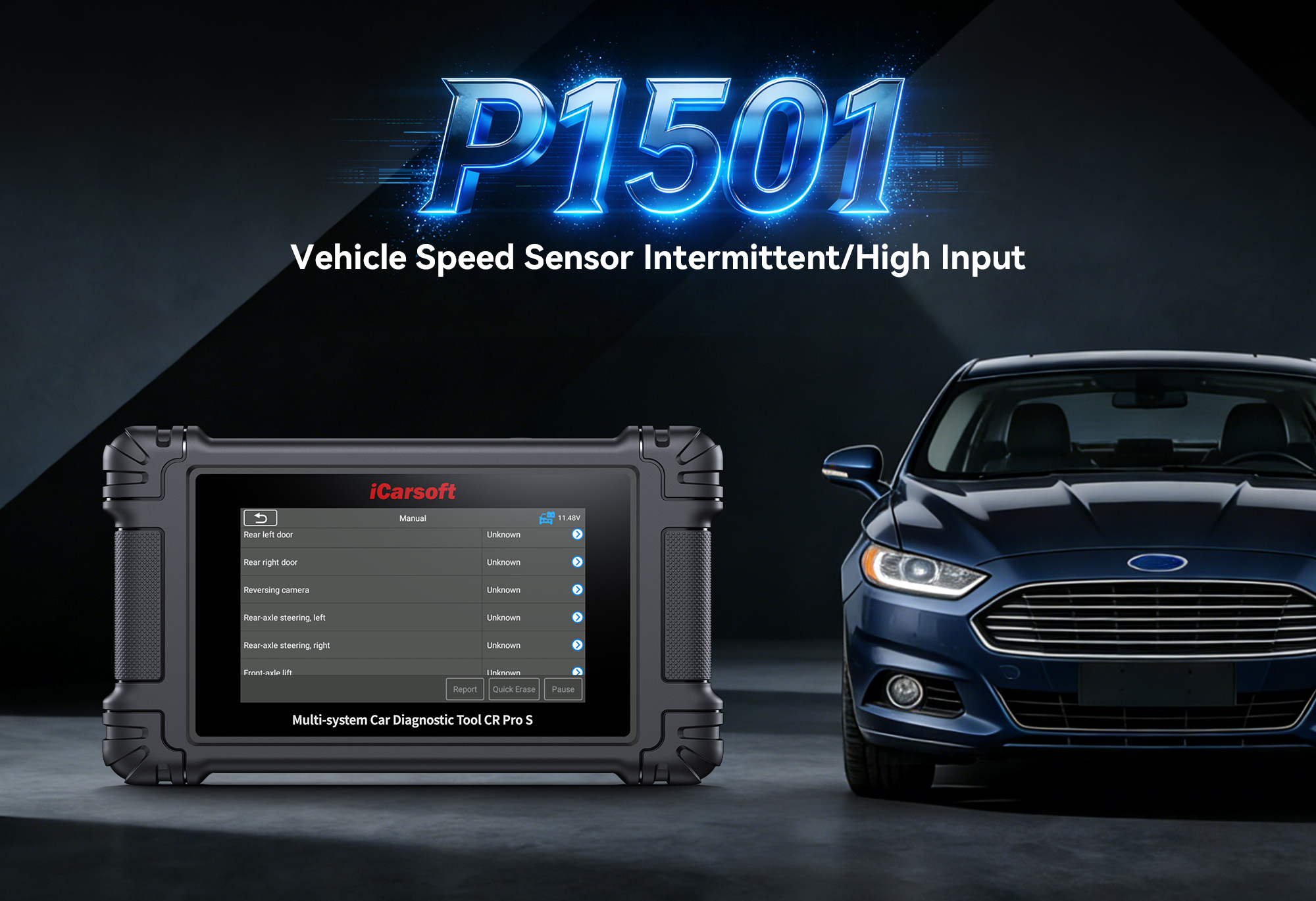Diagnose & Clear P2099 with iCarsoft CR Elite P: Fix Post-Catalyst Fuel Trim System Rich
If your vehicle’s check engine light illuminates, you smell strong gasoline fumes from the exhaust, or notice reduced fuel efficiency, a diagnostic scan will likely return P2099. This OBD-II code stands for "Post-Catalyst Fuel Trim System Rich"—a critical fault indicating the Engine Control Module (ECM) has detected an excessively rich air-fuel mixture after the catalytic converter. The post-catalyst oxygen (O2) sensor monitors exhaust gases to ensure the catalyst is working; a rich mixture here means unburned fuel is reaching the catalyst, risking overheating, damage, and failed emissions tests.
Basic scanners may only flag "fuel trim rich" but can’t analyze live fuel trim data, test O2 sensor response, or check fuel system components—leaving you guessing between issues like leaky injectors, faulty sensors, or clogged air filters. The iCarsoft CR Elite P, with its specialized fuel system diagnostics, O2 sensor validation, and live data tracking, solves this. Let’s break down how to diagnose and resolve P2099 with precision, leveraging the CR Elite P’s unique capabilities to protect your engine and catalytic converter.
Understanding P2099: Causes & Key Symptoms
A post-catalyst rich mixture occurs when more fuel than air enters the combustion chamber (or unburned fuel escapes into the exhaust)—symptoms worsen as unburned fuel damages the catalyst and reduces engine efficiency:
Key Symptoms of P2099
-
Check Engine Light (CEL): The CEL triggers for P2099—some vehicles also display a "Service Emissions System" warning.
-
Strong Gasoline Odor: Unburned fuel in the exhaust creates a noticeable gasoline smell, especially during acceleration.
-
Reduced Fuel Efficiency: A rich mixture burns more fuel than needed—mileage can drop by 15–25%.
-
Rough Idle & Misfires: Excess fuel disrupts combustion, causing the engine to shake at idle or sputter during driving.
-
Catalytic Converter Overheating: Unburned fuel ignites in the catalyst, raising its temperature above safe levels (over 1,600°F/870°C)—risking meltdown or permanent damage.
-
Failed Emissions Tests: High hydrocarbon (HC) and carbon monoxide (CO) levels from unburned fuel cause the vehicle to fail state emissions inspections.
Common Causes of P2099
|
Cause
|
Description
|
|
Leaky Fuel Injectors
|
Worn or damaged injectors drip fuel into the combustion chamber even when closed—adding excess fuel to the mixture.
|
|
Faulty Post-Catalyst O2 Sensor
|
A slow or unresponsive O2 sensor sends incorrect signals to the ECM, tricking it into adding more fuel.
|
|
Clogged Air Filter
|
A dirty air filter restricts airflow, creating a rich air-fuel ratio (less air = more fuel relative to air).
|
|
Fuel Pressure Regulator Failure
|
A stuck-open regulator increases fuel pressure, forcing more fuel into the engine than the ECM commands.
|
|
Vacuum Leaks (Unmetered Air)
|
Leaks in the intake manifold (after the mass airflow sensor, MAF) let unmeasured air enter—confusing the ECM, which adds extra fuel to compensate.
|
|
Faulty MAF Sensor
|
A dirty or failed MAF sensor underreports airflow, leading the ECM to overfuel the engine.
|
Why iCarsoft CR Elite P Excels at Diagnosing P2099
The CR Elite P outperforms basic tools with features tailored to fuel trim and emissions systems—critical for resolving P2099:
Live Fuel Trim Monitoring
Tracks short-term fuel trim (STFT) and long-term fuel trim (LTFT) for both pre- and post-catalyst banks, showing if the ECM is overcompensating for a rich mixture (LTFT < -10% = rich).
O2 Sensor Response Tests
Measures the post-catalyst O2 sensor’s speed and accuracy—slow response or constant rich readings confirm a faulty sensor.
Fuel Pressure Tracking
Monitors fuel rail pressure in real time, identifying high pressure (from a bad regulator) that causes overfueling.
MAF Sensor Validation
Tests the MAF sensor’s airflow readings against manufacturer specs—underreported airflow points to a MAF issue.
AutoVIN Identify
Automatically retrieves your vehicle’s make, model, and engine type in seconds, ensuring access to fuel system-specific specs.
Global Vehicle Coverage
Works with 500+ gasoline and hybrid models from Ford, Chevrolet, Toyota, Honda, BMW—supports single- and dual-catalyst systems.
Fuel Injector Balance Tests
Checks if injectors are delivering equal fuel amounts—imbalanced flow indicates leaky injectors.
Step-by-Step: Diagnose P2099 with iCarsoft CR Elite P
-
1. Initial Visual & Basic Checks
Start with simple, low-cost checks to rule out common issues before advanced diagnostics:
1. Inspect the Air Filter: Locate the air filter housing (usually near the MAF sensor) and remove the filter—if it’s dirty, clogged with dust/debris, or oil-soaked, replace it.
2. Check for Fuel Leaks: Inspect fuel lines, injectors, and the fuel pressure regulator for visible leaks—dampness or gasoline stains indicate a leak (fix immediately).
3. Examine Vacuum Hoses: Look for cracked, disconnected, or collapsed vacuum hoses (especially near the intake manifold)—replace damaged hoses.
-
2. Connect the CR Elite P & Confirm P2099
1. Plug the CR Elite P into your vehicle’s OBD-II port. Power on the tool and select AutoVIN Identify to detect your engine type and fuel system.
2. Navigate to Engine > Fault Codes > Read Codes to confirm P2099. Tap Code Details for vehicle-specific insights.
3. Check for related codes (e.g., P0172, P0138) that indicate pre-catalyst rich conditions or faulty O2 sensors—resolve these first.
-
3. Monitor Live Fuel Trim & O2 Sensor Data
Real-time data reveals if the rich mixture is caused by the fuel system, sensors, or airflow issues:
1. Start the engine and let it warm to operating temperature (10–15 minutes—coolant temp >80°C).
2. Navigate to Engine > Live Data > Fuel System and monitor:
- Post-Catalyst LTFT: Should stay between -10% and +10%. Values < -10% = rich mixture.
- Post-Catalyst O2 Sensor Voltage: Normal voltage fluctuates between 0.1V (lean) and 0.9V (rich) every 1–2 seconds.
- Fuel Rail Pressure: Check against manufacturer specs (e.g., 40–60 psi for port injection).
- MAF Sensor Airflow: Ensure airflow matches engine load (e.g., 2–5 g/s at idle).
-
4. Test the Post-Catalyst O2 Sensor
A faulty O2 sensor is a top cause of false P2099 codes—use the CR Elite P to validate its functionality:
1. O2 Sensor Response Test: Navigate to Special Functions > Engine > O2 Sensor Test. Rev the engine to 2,000 RPM—good sensors switch 5–10 times in 10 seconds; bad ones switch <3 times.
2. O2 Sensor Heater Test: Select O2 Sensor Heater Test to check heater resistance. Compare to specs (10–25 ohms)—0 ohms (short) or infinite ohms (open) = faulty heater.
-
5. Check Fuel Pressure & Regulator
High fuel pressure forces excess fuel into the engine—test the regulator and fuel rail pressure:
1. Fuel Pressure Test: Connect a pressure gauge to the fuel rail test port (if available). Navigate to Engine > Live Data > Fuel System > Fuel Rail Pressure—gauge and tool readings should match (within 5 psi).
2. Regulator Vacuum Test (vacuum-controlled): Disconnect the vacuum line from the regulator and attach a vacuum gauge. At idle, vacuum should be 18–22 inHg—low/fluctuating vacuum = faulty regulator.
-
6. Test Fuel Injectors for Leaks
Leaky injectors add extra fuel to the combustion chamber—use the CR Elite P to check injector balance:
1. Navigate to Special Functions > Engine > Injector Balance Test.
2. The tool compares fuel delivery across all injectors—imbalanced flow (e.g., 20% difference) indicates a leaky injector.
3. Visual Inspection: Remove the intake manifold (if needed) and inspect injectors for fuel leaks—replace leaky injectors with OEM parts.
-
7. Clean or Replace the MAF Sensor
A dirty MAF sensor underreports airflow, leading the ECM to overfuel—clean it first before replacing:
1. Locate the MAF Sensor: Mounted in the air intake tube between the air filter and throttle body.
2. Clean the Sensor: Disconnect the electrical connector, remove the sensor, and spray with MAF sensor cleaner—let dry completely (5–10 minutes).
3. Reinstall & Test: Reattach the sensor and connector, then monitor MAF airflow via live data—replace if airflow is still low.
-
8. Repair & Clear P2099
Fix the Root Cause (based on diagnostics):
- Clogged Air Filter: Replace with OEM or high-quality aftermarket filter.
- Faulty Post-Catalyst O2 Sensor: Replace the sensor (match OEM part numbers via Part Lookup).
- Leaky Fuel Injectors: Replace faulty injectors and install new O-rings.
- Bad Fuel Pressure Regulator: Replace the regulator (port vs. direct injection compatible).
- Dirty MAF Sensor: Clean (step 7) or replace if cleaning fails.
- Vacuum Leaks: Repair with new hoses or intake manifold gaskets.
Clear the Code: Reconnect the CR Elite P, navigate to Engine > Fault Codes > Clear Codes, and confirm P2099 is deleted.
-
9. Validate the Repair
Ensure the post-catalyst fuel mixture is balanced and P2099 doesn’t return:
1. Start the engine and check for warning lights—no CEL or emissions warnings should illuminate.
2. Test drive for 30–40 minutes (city + highway):
- No gasoline odor from the exhaust.
- Smooth idle (no shaking or misfires).
- Improved fuel efficiency (check Fuel Economy Tracker on supported models).
3. Post-Repair Data Check: Use Live Data > Fuel System to confirm post-catalyst LTFT is -10% to +10% and O2 sensor voltage fluctuates normally.
4. Run the I/M Readiness Test (under OBDII Functions) for emissions compliance.
Preventing P2099 Recurrence
The CR Elite P helps maintain fuel system health and avoid future rich mixture issues:
-
Regular Air Filter Replacement: Use the tool’s Service Reminder to replace the air filter every 15,000–30,000 miles (more often in dusty conditions).
-
O2 Sensor Maintenance: Schedule checks every 60,000 miles—replace pre-catalyst sensors every 100,000 miles and post-catalyst sensors every 150,000 miles.
-
Fuel System Cleaning: Add a fuel injector cleaner every 10,000 miles (use Fuel System Guide recommendations) to prevent injector deposits.
-
MAF Sensor Cleaning: Clean the MAF sensor every 30,000 miles with dedicated MAF cleaner to maintain accurate airflow readings.
Conclusion
P2099’s post-catalyst rich mixture fault threatens both your engine’s performance and the catalytic converter’s lifespan—but the iCarsoft CR Elite P turns complex fuel system diagnostics into a manageable process. With its live fuel trim tracking, O2 sensor tests, and injector balance checks, you can quickly identify cheap fixes (e.g., air filter replacement) or target costly repairs (e.g., injector replacement) without guesswork.
For DIYers and professionals alike, the CR Elite P’s fuel system expertise, global coverage, and intuitive interface make it the ideal tool for resolving P2099. Restore balanced fuel trim, protect your catalytic converter, and pass emissions tests—all with one professional-grade diagnostic tool.
FAQs About P2099 Code
Q: Can I drive with P2099?
A: Short distances (to a repair shop) are acceptable, but prolonged driving risks catalytic converter damage from overheating. Fix P2099 within 50–100 miles to avoid costly catalyst replacement.
Q: How much does it cost to fix P2099?
A: Costs range from $20–$50 for an air filter replacement, $80–$200 for an O2 sensor, $150–$400 for a fuel pressure regulator, and $300–$800 for fuel injector replacement (parts + labor). The CR Elite P saves money by avoiding misdiagnoses.
Q: Why does P2099 return after repair?
A: Unaddressed root causes—e.g., a dirty MAF sensor missed during initial checks, or a secondary vacuum leak. Use the CR Elite P’s live data to retest fuel trim and O2 sensor performance post-repair.
Q: Do I need to replace the catalytic converter if P2099 is fixed early?
A: No—if P2099 is resolved within a few hundred miles (before the catalyst overheats or melts), the converter will likely recover. Use the CR Elite P’s emissions tests to confirm catalyst functionality.





